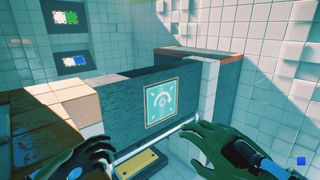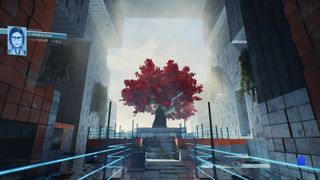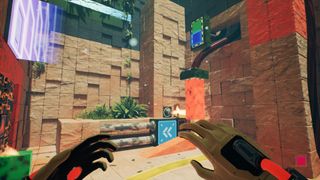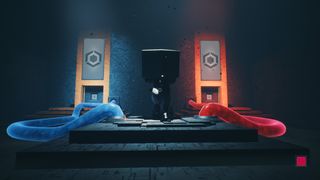How QUBE and QUBE 2 went from student project to whip-smart indie puzzle games
QUBE 2 is out now.

In 2009, three games design students at Newport University were thrown together and given six weeks to create their final project. But none of them knew how to code. "We learnt everything from scratch," says Dan Da Rocha, one of the trio. "It was always going to be a student project—a portfolio piece to go and get a job at a large studio." Soon it was something much bigger, and two years later the group released the game on Steam, where it would go on to reach more than 200,000 players.
What they created in those six weeks was an early version of Q.U.B.E., a first-person puzzle game about manipulating blocks in a 3D environment. They showed it off at their graduation, and their lecturers and the assortment of gathered developers were impressed. Mike Bithell, creator of Thomas Was Alone and Volume, was one of the faces among the crowd. "He told us we should go indie, and we were like, 'Indie, what's that?'"
They'd soon find out. After a couple of rounds of funding, and lots of iteration, the trio had a fully-formed game ready to go. It was smart puzzler with lots of potential, but as PC Gamer's review said at the time, it had too few ideas to be a classic. Its plain white walls felt sterile, devoid of personality—a world away from Portal, which it was inevitably compared to.

This month the group—now called Toxic Games—released a sequel that improves on the original in nearly every way. It's one of the most accomplished puzzlers this year, and a very pretty game too. So how did the team go from humble student project to tight, polished puzzler? I spoke to Da Rocha, now the developer’s managing director, to find out.
Toxic Games made the original Q.U.B.E. without an art team, and opted to "play to its strengths" with minimalist visuals that would let the puzzles shine. In Q.U.B.E. 2, they've gone all out. The game is split into district areas—one an overgrown forest where you jump over the gnarly roots of thick trees, the next built from cavernous laboratory chambers with rotating walls. It's all full of color and shiny surfaces that amplify the stylish lighting.
The art team initially pictured the player being stranded in the desert, but were inspired to add more varied environments by The Crystal Maze, a cult-classic British game show in which teams travel through themed sectors completing puzzles and obstacle courses. "The same white, sterile environment can get a bit tiring on your eyes, a bit intense," Da Rocha says. "So we wanted to make it much more colorful and go for some different themes: a jungle theme, a sand theme."

"We brought in an art director and took a chance on a graduate environment artist, and he knocked it out of the park with the assets. Our producer and writer Ben Hill had a clear vision of what the environment would look like, so they all liaised together to create this beautiful world." The key was attention to detail. Art director Harry Corr knew the game’s environment so well by the end that at one point in development he spotted a single light shaft out of place.
The biggest gaming news, reviews and hardware deals
Keep up to date with the most important stories and the best deals, as picked by the PC Gamer team.
Switching the magnet's polarity lets you surf that block over the airflow of a fan, which nudges your trajectory just enough for you to make it onto a high ledge and exit the level.
It's not just a better-looking game—it's more complex, and its puzzles are more satisfying to solve. In the original you could only place a block of a certain color on a predefined surface, marked by the corresponding color. In Q.U.B.E. 2, you can place any block in any available spot, which requires a little more thought. The number of cubes goes down from five to three—Da Rocha says that was "cutting the fat"—but to make up for the change it introduces magnets, oil slicks, fans that make you float, and doors that have to be burned to open.
Individually, these mechanics are hardly ground-breaking, but Q.U.B.E. 2 does an excellent job making you feel like you're mastering its toolset by gradually ramping up the complexity. "We wanted to keep it very simple and build complexity into the puzzles themselves. We wanted to make it easier to understand," Da Rocha says. The team wanted each mechanic, introduced one-by-one as you progress, to feel like a "new toy to play with." That means you're given three or four easy puzzles when you first encounter each one, and then pushed onto trickier tasks.

The best thing about them is how they interact, and how the game creates challenges by layering them on top of each other. When you first come across the magnets, for example, you'll simply be bouncing cubes into their range, rotating them so they face a door, and then switching them to 'repel', which makes them fire the block out and smash the door down.
Soon you're using them in conjunction with previously introduced mechanics. In one memorable puzzle you use the attract/repel switches to fling a block across the map and then, eventually, you end up standing on top of that block while a magnet holds it in place. Switching the magnet's polarity lets you surf that block over the airflow of a fan, which nudges your trajectory just enough for you to make it onto a high ledge and exit the level. Sticking that landing made me grin for a good few minutes.
By the end you're playing with four or five different systems at a time. One of the final puzzles requires you to continuously rotate a wall using the magnet that's sticking to it to catch a block that you've bounced from on high. Meanwhile, you're coating a different block in oil so that you can skid it across the level, timing a switch for a flamethrower to set that block on fire at just the right moment so that you can then nudge it into a flammable door. It all gets pretty complex, and some of the later puzzles might require a full half hour of head-scratching before you crack them.

Another part of what makes Q.U.B.E. 2 a better game is Toxic Games' growth behind the scenes. The initial team of three is now eight-strong, and unfilled positions were taken up by contractors, including a producer to keep everything on schedule. That means that Da Rocha and the core team could spend more time on the game itself. "In Q.U.B.E. 1 it was us wearing many hats, which is probably good for us in the long-term, but in the short-term it's a killer. If you’re doing the design of the game then the business development will suffer, so with this we've got key people involved in every aspect. That's freed up time to work on the development and the fun stuff."
At the moment, we're looking at other stuff. We've done some other prototypes, and we're taking a little mental break.
Dan Da Rocha
The team all worked remotely, but the end result is coherent. Its one weakness is the story, which is muddled, takes itself too seriously, and involves a few too many logical leaps. The basic premise is that you're archaeologist Amelia Cross, and you wake up in an alien landscape with no idea how you got there. It's set up to be a personal tale about her family, which you find out about through inner monologue, but then goes off-track and ends up being about the relationship between humans and a strange race of machines.
You're given zero reason to care about these machines other than the fact that they (mild spoiler alert) are in control of the landscape that you're puzzling through. The game doesn't devote enough time to dialogue to explain this properly, and as a result tries to pack too much into each encounter with another character, which just left me confused.

It does provide breaks in pace, and some of the dialogue happens when you're confronted with the game's most dramatic vistas so you can admire the view while you listen in. It's unobtrusive enough that it never stopped me from enjoying Q.U.B.E. 2's puzzles, which is where the meat of the game lies, just like in the first game—which barely had a story at all until they added one in a Director's Cut edition.
Whether the overall improved sequel hits its mark with players as well as the original remains to be seen, but regardless, it might well be the last Q.U.B.E. game the studio makes. When I ask Da Rocha whether he's working on a third, he chuckles. "We've joked about it. At the moment, we're looking at other stuff. We've done some other prototypes, and we're taking a little mental break." He mentions that some of the team, during development of Q.U.B.E. 2, worked on Thorn, an experimental sci-fi job simulator that came out exclusively in a Humble Bundle. "We want to explore that further."
The fact there may not be another Q.U.B.E. game makes this one feel even more special. Despite its narrative flaws, it's a game that any puzzle fan should play, and the fact that nine years ago it was just an idea by three undergraduate students is testament to the power of the indie scene to reward original ideas.
Samuel Horti is a long-time freelance writer for PC Gamer based in the UK, who loves RPGs and making long lists of games he'll never have time to play.
Most Popular

